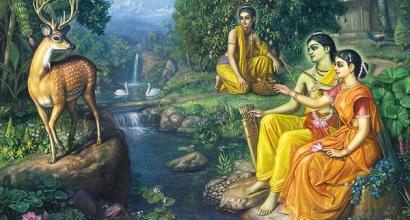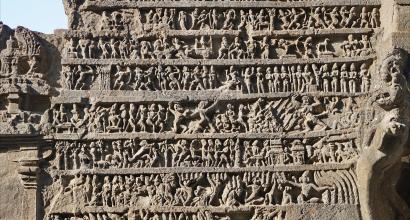The story that began in Pratijñā-yaugandharāyaṇa continues in the play Svapna-vāsavadatta. Yaugandharāyaṇa and Vāsava-dattā work together in order to get Udayana married to Padmāvatī. In this play too, Udayana does not come to the fore as the primary character. Though Padmāvatī plays a prominent role, Vāsava-dattā is a more important character. Every event is designed with Vāsava-dattā as the locus. Udayana feels as if he saw her in his svapna – dream and the story goes ahead to tell us the reason behind the dream and its effect on the rest of the characters. The focus is not on Padmāvatī’s kalyāṇa – wedding. Thus, the name of the play is amply justified.
The love that Vāsava-dattā and Udayana have for each other gets portrayed very well in the play. They are no longer the young couple that eloped and got married without informing the elders. Their love is now matured, sweet, and stable. Their feelings for each other cannot be ruptured by anyone. The story shows us the sublimity of their love. Their deep feeling for each other helps them overcome their selfish desires. Here, Udayana is not a dhīra-lalita-nāyaka who runs behind the women of antaḥpura. He marries the young Padmāvatī, who is noble and beautiful; he does so not out of his own will but because the others insisted and he was made to believe that Vāsava-dattā had passed away. Even after he marries Padmāvatī, he keeps craving for the company of Vāsava-dattā and laments; he even sees her in his dream; Vāsava-dattā, who is alive, happens to see him asleep in the samudra-gṛha; she lifts his arm, which was stretching out of his bed and places it at his side; he immediately wakes up from his sleep recognising Vāsava-dattā’s touch.
Vāsava-dattā accepts the second marriage of her husband for the sake of the kingdom and his own welfare. Even when she is sitting away, all alone, on stone bench in a garden, royal servants come there asking her to string together the wedding garland of her husband with her co-wife. She is in a fix – she cannot speak her heart nor can she refuse doing the job; she is unable to bear the pain of seeing her husband slipping away from her hands too. Though her beloved is right in front of her eyes, she can neither gaze at him without hesitation nor speak to him. Yet, the poet brings her in the middle of the night to her husband’s half occupied bed when no one else is around. She mistakes him for Padmāvatī and sleeps next to him. As the audience gets more and more curious about the plot, they witness Udayana talking in his sleep. He calls out, “Vāsava-dattā, Vāsava-dattā!” Vāsava-dattā then gets to know that she was actually sleeping next to Udayana and thinks that he is calling her name in the state of wakefulness – her mental state at this juncture is left to us to imagine. The kind of skill that is needed to enact this role is tremendous. This is the sequence of svapna, that lies at the heart of this play. There are many other sequences in the play which provide deep rasa experience and reveal the nature of different characters. Bhāsa has displayed great creative skill in stringing together the story and knitting the plot. In one instance, Padmāvatī starts a conversation, which, in essence tells us that Vāsava-dattā was dearer to Udayana. In another, the ceṭī ensures that Vatsa-rāja and vidūṣaka do not enter the latā-gṛha by provoking bees, and thereby, helps Vāsava-dattā escape from there by hiding his face behind a handkerchief. These serve as good examples for the creative techniques used by the poet.
The poet has not introduced any event or character which does not contribute to the Rasa experience. In fact, the play does not even name the parents of Padmāvatī; it only mentions that Darśaka is her elder brother. The names of the tāpasī, kañcukī, and ceṭī are not mentioned either. Thus, their deeds make a mark in our hearts and reveal their personality. The play does not contain too many verses; if they were to be present, it would have hindered the speed of the play. It has only about fifty-seven verses. As the play has been knitted keeping Rasa as the primary focus, it does not include unnecessary varṇanā – descriptions and unnatural figures of speech. Similarly, the play is devoid of preachy segments. Descriptions are included only when the context demands. For instance, the description of the āśramas of ṛṣis, evenings, and bedroom, as well as the portrayal of Vāsava-dattā are pleasing. The ups and downs in life, i.e., bhāgya-paṅkti is compared to the rim of a wheel, i.e., cakrāra-paṅkti. The village of Lāvāṇaka, which was abandoned by Udayana is compared to the night sky devoid of the moon and stars. The anxious Avanti-sundarī, who is Vāsava-dattā in disguise is compared to the orb of the moon covered by mist. A person, whose life is coming to an end is said to be like an earthen pot with its rope snapped.
The play is filled with suggestions of the future – they create wonder and add to the Rasa. For instance, a brahmacārī declares, ‘Though Vāsava-dattā is burnt, she isn’t.’ Although the brahmacārī’s intention is different, readers may feel a little relived thinking that Vāsava-dattā is, perhaps, alive. The tāpasī blesses Padmāvatī that she gets married to the best suited man and wishes Vāsava-dattā that she reunites with her husband at the earliest. Thus, the fruit that is going to ripen later gets revealed in its root; the conclusion of the play is suggested right at the beginning. Similar is the sequence where Udayana examines a painting.
The play is not filled with supernatural events, the presence of which can potentially turn it into a mad rave party. The emotions are natural and subtle. Everything is gentle, soft, and sweet. The characters care for the emotions of the others and are so sāttvic that they don’t wish to hurt anybody. In summary, it results in a family filled with love. It is thus really befitting that this work has been paid great tributes by Rājaśekhara and other ancient poets.
As Svapna-vāsava-dattā is the most famous among Bhāsa’s plays and Pratijñā-yaugandharāyaṇa forms its prequel, we took them up for analysis first. In fact, we should have started examining the play Avimāraka – this is based on the popular folk stories as well. There are many significant reasons to consider this as the first work of Bhāsa.
The current series of articles is an enlarged adaption of Prof. A. R. Krishnasastri's Kannada treatise Saṃskṛta-nāṭaka. They are presented along with additional information and footnotes by Arjun Bharadwaj.














































